Mitsubishi Outlander: On-vehicle Service
CHECK AT A/C-ECU TERMINAL
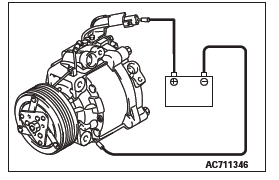
1. Disconnect the A/C compressor clutch connector to the A/C compressor clutch.
2. Connect positive battery voltage directly to the connector for the A/C compressor clutch.
3. If the A/C compressor clutch is normal, there will be a "click".
If the pulley and armature do not make contact ("no click"), there is a malfunction.
SIMPLE INSPECTION OF THE A/C PRESSURE SENSOR
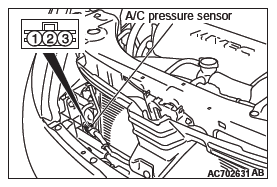
1. Assemble a gauge manifold on the high-pressure service valve.
2. Disconnect the A/C pressure sensor connector and connect special tool test harness MB991658 as shown in the illustration.

3. Turn ON the engine and then turn ON the A/C switch.

4. At this time, check to see that the voltage of A/C pressure sensor terminal No. 2 reflects the specifications of the figure.
NOTE: The allowance shall be defined as +-5%.
COMPRESSOR DRIVE BELT ADJUSTMENT
Refer to GROUP 11A, on-vehicle service − drive belt tension check. <2.4L>
Refer to GROUP 11C, on-vehicle service − generator drive belt tension check. <3.0L>
REFRIGERANT LEVEL CHECK, DRAINING, AND CHARGING
REFRIGERANT LEVEL TEST
Use the refrigerant recovery station to remove all of the refrigerant, and then calculate the amount of the refrigerant and charge it.
NOTE: Refer to the Refrigerant Recovery and Recycling Unit's Instruction Manual for operation of the unit.
METHOD BY USING REFRIGERANT RECOVERY AND RECYCLING UNIT
Using the refrigerant recovery and recycling unit, refill the refrigerant.
NOTE: Refer to the Refrigerant Recovery and Recycling Unit's Instruction Manual for operation of the unit.
DISCHARGING SYSTEM
Use the refrigerant recovery unit to discharge refrigerant gas from the system.
NOTE: Refer to the Refrigerant Recovery and Recycling Unit's Instruction Manual for operation of the unit.
CHARGING
Use the refrigerant recovery station to charge the refrigerant.
NOTE: Refer to the Refrigerant Recovery and Recycling Unit's Instruction Manual for operation of the unit.
REFILLING OF OIL IN THE A/C SYSTEM
Too little oil will provide inadequate compressor lubrication and cause a compressor failure. Too much oil will increase discharge air temperature.
When a compressor is installed at the factory, it contains 80 cm3 (4.7 fl.oz) of refrigerant oil. While the A/C system is in operation, the oil is carried through the entire system by the refrigerant. Some of this oil will be trapped and retained in various parts of the system.
When the following system components are changed, it is necessary to add oil to the system to replace the oil being removed with the component.
Compressor oil: SUN PAG 56
Quantity:
Evaporator: 60 cm3 (2.0 fl.oz)
Condenser: 15 cm3 (0.5 fl.oz)
Suction hose: 10 cm3 (0.3 fl.oz)
PERFORMANCE TEST

The vehicles to be tested should be parked out of direct sunlight.
1. Close the high and low-pressure valve of the gauge manifold.
2. Connect the charging hose (blue) to the low-pressure valve and connect the charging hose (red) to the high-pressure valve of the gauge manifold.
3. Install the quick joint (for low-pressure) to the charging hose (blue), and connect the quick joint (for high-pressure) to the charging hose (red).
CAUTION
- To connect the quick joint, press section A firmly against the service valve until a click is heard.
- When connecting, run your hand along the hose while pressing to ensure that there are no bends in the hose.
4. Connect the quick joint (for low-pressure) to the low-pressure service valve and connect the quick joint (for high-pressure) to the high-pressure service valve.
NOTE: The high-pressure service valve is on the A/C pipe and the low-pressure service valve is on the suction hose.
5. Start the engine.
6. Set the A/C controls as follows:
- A/C switch: A/C − ON position
- Mode selection: FACE position
- Temperature control: MAXIMUM COOLING position
- Air selection: RECIRCULATION position
- Blower switch: Maximum air volume
7. Adjust engine speed to idle speed with A/C clutch engaged.
8. Engine should be warmed up with doors and windows opened.
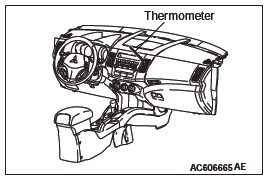
9. Insert a thermometer in the center air outlet and operate the engine for 20 minutes.
NOTE: If the A/C clutch cycles, take the reading before the clutch disengages.
10.Note the discharge air temperature.
PERFORMANCE TEMPERATURE CHART

REFRIGERANT LEAK REPAIR PROCEDURE
LOST CHARGE
If the system has lost all charge due to a leak:
1. Evacuate the system. 2. Charge the system with approximately 0.453 kg (1 pound) of refrigerant.
3. Check for leaks.
4. Discharge the system.
5. Repair leaks.
CAUTION Replacement filter-drier units must be sealed while in storage. The drier used in these units will saturate water quickly upon exposure to the atmosphere. When installing a drier, have all tools and supplies ready for quick assembly to avoid keeping the system open any longer than necessary.
6. Replace receiver drier.
7. Evacuate and charge system.
LOW CHARGE
If the system has not lost all of its refrigerant charge; locate and repair all leaks. If it is necessary to increase the system pressure to find the leak (because of an especially low charge) add refrigerant.
If it is possible to repair the leak without discharging the refrigerant system, use the procedure for correcting low refrigerant level.
HANDLING TUBING AND FITTINGS
Kinks in the refrigerant tubing or sharp bends in the refrigerant hose lines will greatly reduce the capacity of the entire system. High pressures are produced in the system when it is operating. Extreme care must be exercised to make sure that all connections are pressure tight. Dirt and moisture can enter the system when it is opened for repair or replacement of lines or components. The following precautions must be observed. The system must be completely discharged before opening any fitting of connection in the refrigeration system. Open fittings with caution even after the system has been discharged. If any pressure is noticed as a fitting is loosened, allow trapped pressure to bleed off very slowly.
Never attempt to rebend formed lines to fit. Use the correct line for the installation you are servicing. A good rule for the flexible hose lines is keep the radius of all bends at least 10 times the diameter of the hose.
Sharper bends will reduce the flow of refrigerant. The flexible hose lines should be routed so that they are at least 80 mm (3.1 inches) from the exhaust manifold.
It is good practice to inspect all flexible hose lines at least once a year to make sure they are in good condition and properly routed.
On standard plumbing fittings with O-rings, these O-rings are not reusable.
COMPRESSOR NOISE CHECK
You must first know the conditions when the noise occurs. These conditions are: weather, vehicle speed, in gear or neutral, engine temperature or any other special conditions.
Noises that develop during A/C operation can often be misleading. For example: what sounds like a failed front bearing or connecting rod, may be caused by loose bolts, nuts, mounting brackets, or a loose clutch assembly. Verify accessory drive belt tension (power steering or generator).
Improper accessory drive belt tension can cause a misleading noise when the compressor is engaged and little or no noise when the compressor is disengaged.
Drive belts are speed-sensitive. That is, at different engine speeds, and depending upon belt tension, belts can develop unusual noises that are often mistaken for mechanical problems within the compressor.
ADJUSTMENT
1. Select a quiet area for testing. Duplicate conditions as much as possible. Switch the compressor on and off several times to clearly identify compressor noise. To duplicate high ambient conditions (high head pressure), restrict air flow through the condenser. Install a manifold gauge set to make sure discharge pressure doesn't exceed 2,070 kPa (300.2 psi).
2. Tighten all compressor mounting bolts, clutch mounting bolt, and compressor drive belt. Check to assure clutch coil is tight (no rotation or wobble).
3. Check refrigerant hoses for rubbing or interference that can cause unusual noises.
4. Check refrigerant charge.
5. Recheck compressor noise as in Step 1.
6. If noise still exists, loosen compressor mounting bolts and retighten. Repeat Step 1.
7. If noise continues, replace compressor and repeat from Step 1.
POWER RELAY CHECK
BLOWER RELAY CONTINUITY CHECK


A/C COMPRESSOR CLUTCH RELAY CONTINUITY CHECK


FAN CONTROL RELAY CONTINUITY CHECK

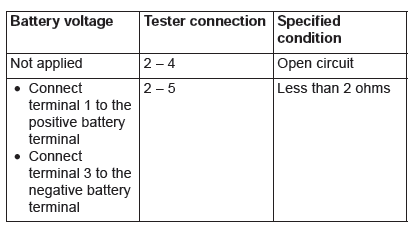
CONDENSER FAN RELAY CONTINUITY CHECK


IDLE-UP OPERATION CHECK
Before inspection and adjustment, set vehicle in the following condition:
- Engine coolant temperature: 80 − 90 ºC (176.0 − 194.0 ºF)
- Lights, electric cooling fan and accessories: OFF
- Transaxle: Neutral ("N" or "P" position)
- Steering wheel: Straightforward
1. Check whether or not the idle speed is the standard value.
Refer to GROUP 11A, On-vehicle Service − Idle Speed Check. <2.4L>
Refer to GROUP 11C, On-vehicle Service − Idle Speed Check. <3.0L>
<2.4L>
650 +- 100 r/min
<3.0L>
600 +- 100 r/min
2. Turn on the A/C switch and the blower speed selection dial.
Engine idling speed should be within the standard value:
Standard value: 800 +- 50 r/min
NOTE: The powertrain control module determines whether the A/C load is low or high according to the output signal from the A/C-ECU.
NOTE: It is not necessary to make an adjustment, because the idling speed is automatically adjusted by the ISC system.
If, however, a deviation from the standard value occurs for some reason, check the ISC system.
REPLACE THE CLEAN AIR FILTER

1. Remove the glove box.
2. Loosen the two lugs as shown to replace the clean air filter.
3. Install the glove box.
A/C Control Panel Assembly
REMOVAL AND INSTALLATION
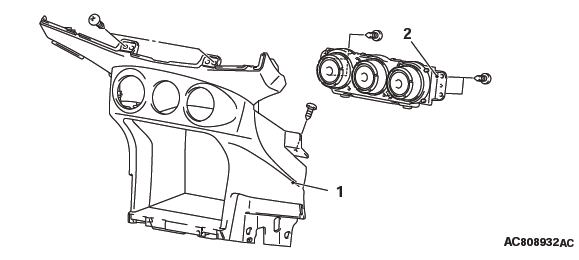
Removal steps
- Center lower panel
- A/C control panel

